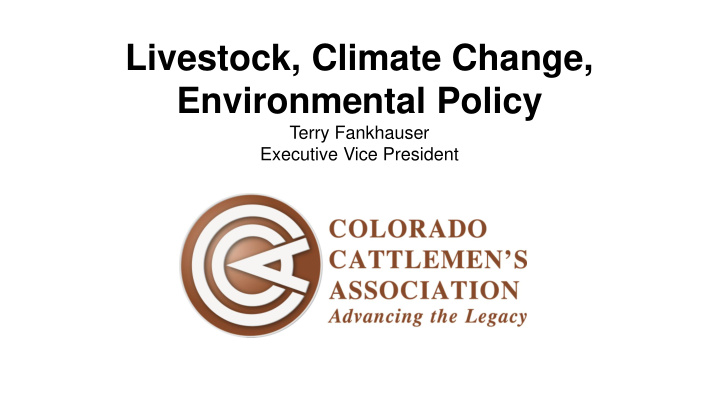



Livestock, Climate Change, Environmental Policy Terry Fankhauser Executive Vice President
Methane Significant trends for the largest sources of U.S. Methane emissions include the following: • Enteric fermentation is the largest anthropogenic source of Methane emissions in the United States. In 2016, enteric fermentation CH4 emissions were 170.1 MMT CO2 Eq. (25.9 percent of total Methane emissions), which represents an increase of 6.0 MMT CO2 Eq. (3.6 percent) since 1990. This increase in emissions from 1990 to 2016 generally follows the increasing trends in cattle populations. Enteric fermentation is a natural part of the digestive process in ruminant animals such as cattle , sheep , goats , and buffalo . Microbes in the digestive tract, or rumen, decompose and ferment food, producing methane as a by- product.
Cattle v. Historic Bison Enteric Methane
US Green House Gas Emmissions
Agriculture and Climate Change
EPA Action ** NAEMS: National Air Emissions Monitory Study ** EEM: Emissions Estimating Methodology ** Volatile Organic Compound
“McDonald’s Becomes the First Restaurant Company to Set Approved Science Based Target to Reduce Greenhouse Gas Emissions” March 20, 2018 Company Expected to Prevent 150 Million Metric Tons of Emissions by 2030 Today, McDonald’s announces it will partner with franchisees and suppliers to reduce greenhouse gas emissions related to McDonald’s restaurants and offices by 36% by 2030 from a 2015 base year in a new strategy to address global climate change. Additionally, McDonald’s commits to a 31% reduction in emissions intensity (per metric ton of food and packaging) across its supply chain by 2030 from 2015 levels. This combined target has been approved by the Science Based Targets initiative (SBTi).
USDA Ag Research Study Finds Greenhouse Gas Emissions from U.S. Beef Production and Inputs are NOT “Significant Contributors” to Climate Change… • Total Beef Cattle Production Accounted for 3.3% of All U.S Greenhouse Gas Emissions • Ag in Total Accounted for 9% • Fossil Fuels Used in Beef Production Accounted for Less Thanks 1% Consumed Nationally IN EXCHANGE FOR • More than 40 percent of the land in the contiguous U.S. is pasture and rangeland that is too rocky, steep, and/or arid to support cultivated agriculture – yet this land can support cattle and protein upcycling. • The U.S. produces 18 percent of the world’s beef with just 8 percent of the world’s cattle (ranking third in worldwide total cattle population).
CERCLA Enacted by Congress in 1980 to deal with toxic waste sites EPCRA 1986 amendment to get info to state and local responders
2008 CERCLA / EPCRA Rule • 2008 EPA Rule exempted ag from CERCLA reporting and some from EPCRA reporting • Enviros sued EPA • Nothing happened for 10 years • Court decision in favor of activists in 2017
Remember CAFO Reporting Rule? Activists are using CERCLA reports to create a national list of farm locations, and use reported data to compel EPA to craft agricultural emissions regulations under the Clean Air Act.
Outcome President Trump signed the funding bill in March 2018. Farmers and ranchers are exempt from CERCLA reporting. How? • Designed and executed a thoughtful legislative strategy • Build coalition and got everyone to work together • Grassroots Outreach!
Recommend
More recommend